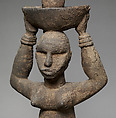Headdress (Ogbom)
Not on view
This Igbo headdress depicts a female figure seated on a wooden stool, carrying a round platter or bowl with a head on top. Like other objects performed in masquerades and ritual, the headdress is encrusted in a dark patina with various pigments and layers. Although the head of the seated figure is rounded, her features are very angular, particularly around the jawline which leads to lips and chin projecting beyond the upper part of the face. The eyes are narrowed and sit beneath overhanging brows. Cicatrization marks are at the center of the forehead. The upper torso consist of carved breasts, a slightly protruding navel, arms extended upward and coiled rings around her wrists. The head on the tray shares similar features, with a rounded head, prominent lips and scarification marks at the center of the forehead. A protrusion juts out from the center of the head, suggesting a type of hairstyle.
The populations’ intermingling, interactions and exchanges along the networks created by the Benue, Kwa and Cross rivers have been extensively investigated by scholars over the past decade and tell a rich story of regional artistic influence. This history is visible through the various forms of headdresses worn in Ogbom dances among the Igbo, Ibeku, Olokoro, Oboro, Ngwa, Ozu-Item, and Ibibio peoples. Each of these dances present their own specificities, but figural headdresses such as this example are central to all of them. They can represent either male or female figures, ranging from naturalistic to highly stylized, either standing or seated on stools, placed atop the head in performance associated to Ala (Earth). The dance called attention to Ala’s role in human and agricultural fertility.
Due to rights restrictions, this image cannot be enlarged, viewed at full screen, or downloaded.
This artwork is meant to be viewed from right to left. Scroll left to view more.






